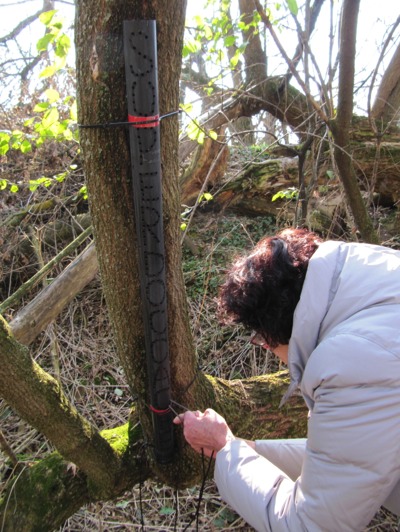
Valiant and determined cacher Nannya is tackling one of Super_Doc's always inventive cache's. Super_Doc supplied the tools that Nannya is using in an attempt to move the cache up, up the container until it reaches the top. First try she made it halfway and then we heard 'clunk' - the cache had fallen all the way back down. Second try was more successful.
BTW those drilled holes spell 'Super Doc Cache'.
BTW those drilled holes spell 'Super Doc Cache'.

Meet Doc aka Super_Doc and Doc's Mom, momma superdoc.
Doc is an 18 year-old disabled adventurer who came to realize that hiding caches is way more fun than finding them. Super_Doc's caches are beloved in the caching community.
Cachers are able to award 'Favorite' points to caches they deem worthy of the distinction. Super_Doc's caches have garnered more 'Favorites' than anyone else in the Region, at this moment surpassing 500 points.
This is an awesome achievement but once you start finding Super_Doc caches you'll understand just how deserving they are.
And, I'm pleased to report, he's not finished any time soon.
Doc is an 18 year-old disabled adventurer who came to realize that hiding caches is way more fun than finding them. Super_Doc's caches are beloved in the caching community.
Cachers are able to award 'Favorite' points to caches they deem worthy of the distinction. Super_Doc's caches have garnered more 'Favorites' than anyone else in the Region, at this moment surpassing 500 points.
This is an awesome achievement but once you start finding Super_Doc caches you'll understand just how deserving they are.
And, I'm pleased to report, he's not finished any time soon.
There is more than one way to geocache. In fact there are several and each provides its own unique set of challenges.
These geocaching types are briefly explained below. To the side is the geocaching icon associated with that geocaching type.
These geocaching types are briefly explained below. To the side is the geocaching icon associated with that geocaching type.

Referred to as 'Traditional' this is what most people think is geocaching. The traditional cache is your Treasure Hunt type of caching activity. You get the coordinates. You try to find the cache. The cache can be any size and may contain many items but each cache will always contain one thing - a logbook.

This symbol refers to a 'Multi-Cache' and just as its name suggests there will be multiple steps that need to be completed before finding the cache. Whereas the Traditional Cache is like a Treasure Hunt think of the Multi-Cache as a Scavenger Hunt. Each step will provide the clue needed to get to the next step.
Ultimately the Multi-Cache will end at a Traditional Cache, log and all.
Ultimately the Multi-Cache will end at a Traditional Cache, log and all.

'Puzzle' or 'Mystery' caches are not for the faint of heart. They are, however, robust challenges of the cerebral variety. Usually one or more puzzles will have to be solved in order to determine the coordinates of the cache. So if you like puzzles, mazel tov.

An 'EarthCache' is a place. The place will be special in the sense that it will be of unique geological or scientific significance to the Earth. 'EarthCaches' will contain educational notes to inform the cacher about that significance. Sometimes homework will be required in order to log an 'EarthCache'.

A 'Wherigo Cache' is a wonderful caching experience in which the cacher is immersed in a GPS enabled virtual adventure. Perhaps you'll be solving a murder mystery (just one type of a 'Whereigo' adventure). The 'Whereigo' experience, called a cartridge (and available only to Whereigo enable GPS units) will have you solve clues step by step until the murder is solved and the cache is found.

An 'Event' cache is just that. It's an event where cachers get together just to, um, get together. But it's a cache so it can be logged and a smiley accorded. Be wary of 'Event' caches. Cachers are usual crazy. Fortunately not in a harmful way.

One specific type of Event is the 'CITO' or 'Cache In Trash Out'. Here a designated area will be targeted for trash removal or tree planting or some other 'giving back' type of activity.

I have read that 150 years ago there was a game called 'Letterboxing' which is very similar to the modern geocaching. Then a letter box was the final destination and clues paved the way to it. Today that can still be the case although often, like other caches, coordinates are provided. It's not unusual in a 'Letterbox' cache to find a hand-fashioned rubber stamp. This is not to be removed. Letterboxers will bring their own pad to print the stamp.